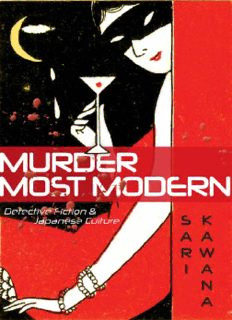
Murder Most Modern: Detective Fiction and Japanese Culture PDF
Preview Murder Most Modern: Detective Fiction and Japanese Culture
Murder Most Modern This page intentionally left blank Murder Most Modern Detective Fiction and Japanese Culture Sari Kawana University of Minnesota Press Minneapolis / London Th e University of Minnesota Press gratefully acknowledges the fi nancial a ssistance provided to support the publication of this book from the College of Liberal Arts, University of Massachusetts Boston. Portions of the Introduction were previously published in “Pleasures of Permutation: Detective Fiction and Cultural Globalization,” Proceedings of the Association for Japanese Literary Studies 5 (Summer 2004); reprinted with permis- sion from the Association for Japanese Literary Studies. A previous version of chapter 3 was published as “Mad Scientists and Th eir Prey: Bioethics, Murder, and Fiction in Interwar Japan,” Journal of Japanese Studies 31, no. 1 (Winter 2005): 89–120; reprinted with permission of Journal of Japanese Studies. Copyright 2008 by the Regents of the University of Minnesota All rights reserved. No part of this publication may be reproduced, stored in a retrieval system, or transmitted, in any form or by any means, electronic, me- chanical, photocopying, recording, or otherwise, without the prior written per- mission of the publisher. Published by the University of Minnesota Press 111 Th ird Avenue South, Suite 290 Minneapolis, MN 55401-2520 http://www.upress.umn.edu Library of Congress Cataloging-in-Publication Data Kawana, Sari. Murder most modern : detective fi ction and Japanese culture / Sari Kawana. p. cm. Includes bibliographical references and index. ISBN 978-0-8166-5025-5 (hc : alk. paper) — ISBN 978-0-8166-5026-2 (pb : alk. paper) 1. Detective and mystery stories, Japanese—History and criticism. 2. Japanese fi ction—20th century—History and criticism. 3. Culture in literature. I. Title. PL747.67.D45K38 2008 895.6'30872—dc22 2008000751 Printed in the United States of America on acid-free paper Th e University of Minnesota is an equal-opportunity educator and employer. 15 14 13 12 11 10 09 08 10 9 8 7 6 5 4 3 2 1 Contents Author’s Note vii Acknowledgments ix Introduction: Detective Fiction, Diphtheria, and Modernity 1 1. Tailing the Tail: How to Turn Paranoia into a Hobby 29 2. Eyeing the Privates: Sexuality as Motive 69 3. Mad Scientists and Their Prey: Bioethics and Murder 111 4. Drafted Detectives and Total War: Three Editors ofShupio 147 5. The Disfi gured National Body: Unmasking Modernity in Postwar Mysteries 186 Epilogue: Beyond the Whodunit 219 Notes 225 Bibliography 251 Index 265 This page intentionally left blank Author’s Note I follow Japanese convention and give Japanese names in tradi- tional order (e.g., Oguri Mushitarō). I refer to authors by the names by which they are best known. Some authors are referred to by sur- name (e.g., Satō Haruo) and others by their pen names (e.g., Edogawa Ranpo, Kuroiwa Ruikō). All translations from the Japanese are mine unless otherwise i ndicated. In the publication citations in the bibliography, the place of publica- tion for all Japanese-language sources is Tokyo unless otherwise noted. vii This page intentionally left blank Acknowledgments The cover and the copyright page suggest that I am the sole author of this book, but the material herein would not have come together without the patience, kindness, and support of numerous people and institutions. My sincere thanks and warmest regards go to my mentors, col- leagues, and friends from my days as a graduate student at the University of Pennsylvania: Bruce Baird, Linda Chance, Jennifer Chen, Rita Copeland, Edward Drott, Jonathan Eburne, Gregory Flaxman, Stephen Hock, G. Cameron Hurst, Ayako Kano, William LaFleur, Gerald Prince, Deborah Shapple, Matthew Sommer, Sayumi Takahashi, and Liliane Weissberg. Penn’s University and SAS Dissertation Fellowships funded the research and writing of my dissertation, on which this book is based. At various points during my dissertation research, I received invaluable help from archives in Japan, including the Nihon Kindai Bungakukan, the Setagaya Bungakukan, and the Misuterī Shiryōkan, as well as individual libraries at the University of Tokyo. Also, I would like to thank the many scholars and afi cionados of detective fi ction and modan culture that I met along the way: Aizu Shingo, Endō Tomomi, Hayashi Katsurō, Jiichi, Taniguchi Yōko, Uchida Ryūzō, Yohara Takao, Yoshimi Shun’ya, and Yuasa Atsushi. I extend my gratitude to those individuals and institutions that kindly granted permission to reproduce their images: Asahi Shinbun, Hirai Ryūtarō, Mainichi Shinbunsha, Shiozawa Tamae, Tsutsumi Naruki, Yonezawa Yoshihiro, and Yoshida Kanoko. ix
Description: